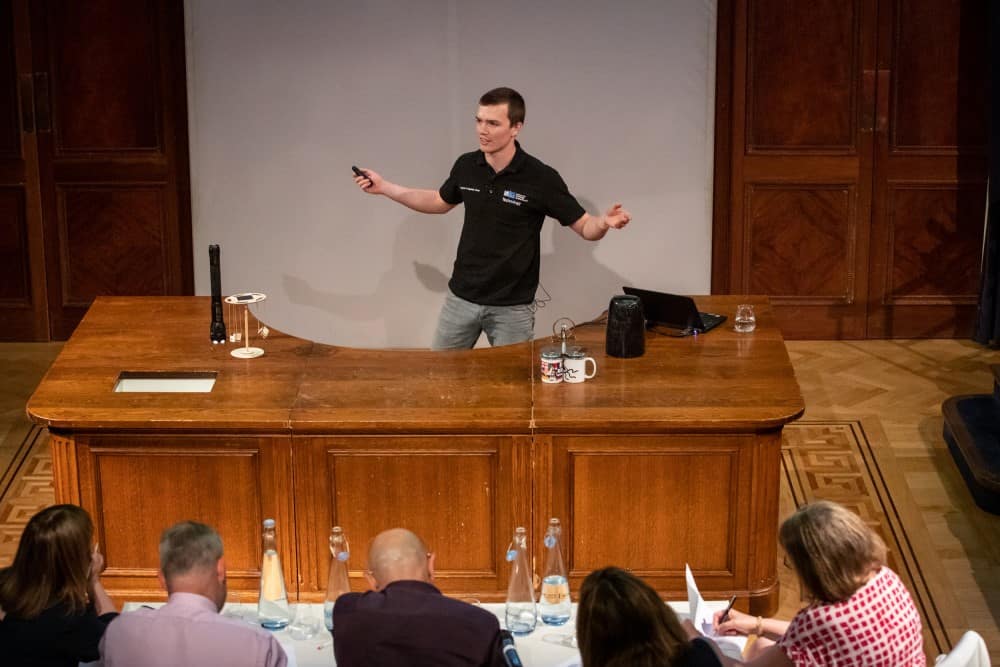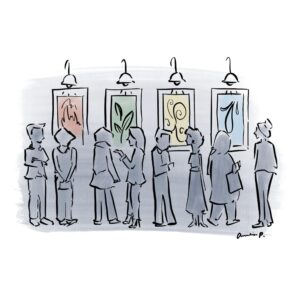After so many years stuck behind screens, have we lost the art of networking? James McKenzie reminds us why it’s important to get out there and meet people face to face

Networking events are back – at least they are in my day-to-day business activities. Sure, I picked up lots of great online networking skills during the Covid pandemic. But it’s fun – and often essential – to return to the old-school methods of talking to people face to face, going to conferences and attending trade shows. If you’re lucky, you could even go on a trade mission.
In fact, I’m surprised how many events I went to in 2023 and how important they’ve been to my business activities. Some people, I found, were rusty after sitting behind their keyboards for so long. If you work in industry, as I do, what’s vital is to craft a high-quality, concise introduction to yourself, your company and your aims.
The classic “elevator pitch” – a pithy, 30-second summary to sell yourself or your product – is vital in many social and business situations. You need to be able to deliver a short, positive and punchy introduction to yourself and then ask the other person about themselves. If they respond with a similarly punchy pitch, you’ll soon know if you have – or haven’t – got something of mutual interest to discuss.
But even if the person you’re talking to doesn’t seem of interest, their work may be relevant in the future so I always share contact details; you never know where life will take you. So swap business cards, QR codes to your LinkedIn profile or whatever you think is appropriate, and thank them for their time. Networking events can be awkward and nerve wracking, but this strategy works well – after all, the other person is likely to be on a similar mission.
Mission accomplished
One networking highlight for me last year was a week-long trade mission to India I went on as part of Innovate UK’s Global Business Innovation Partnership (GBIP) programme. Focused on “power electronics, motors and drives”, it took me to various automotive manufacturing centres and companies in Chennai and Pune. Delegates have to apply to take part, with Innovate UK typically selecting representatives from a dozen or so relevant UK firms.
Designed to help stimulate collaboration and partnerships, the mission started with a briefing session in the UK detailing the programme’s aims and the places to be visited. In fact, the session was a great way introduce yourself and your company to others on the programme. As for the visit itself, it gave me incredible opportunities to meet businesses and organizations I’d perhaps otherwise have no chance of meeting.
Even the bus rides between events were a great way to meet the other firms taking part.
We made up to five visits per day, describing our companies at each event through 30-second to one-minute elevator pitches. Once everyone knew what we did, there were opportunities to meet potential partner organizations for more in-depth discussions. Even the bus rides between events were a great way to meet the other UK firms taking part and bond with others on the mission – none of us can forget the moment suitcases broke free from the coach and bounced down the road causing traffic chaos.
We had some other pretty amazing experiences on the trip, including a visit to several companies building electric buses and cars. At Bajaj Autos, which is one of the largest manufacturer of scooters and “tuk-tuk” three-wheelers, we even got to ride some of the terrifyingly quick electric prototypes. We also went to regional trade-association meetings attended by 150 or so people, as well as vast research institutes. There was also an amazing drinks reception at the British High Commissioner’s residence in Chennai.
At the end of the week, I made several key business connections and got through a full box of business cards. Whereas I don’t think I’d used any at all in previous years, I quickly discovered that they’re a key part of doing business in India. In fact, the trade mission proved so useful that I applied for – and went on – another trip to Canada in early December. It was just as useful, if 50 ºC colder.
Out and about
Not everyone can go on trade missions, but good networking skills are just as useful at trade shows and conferences. During the pandemic, most such events went virtual or were cancelled – but now they’re back with a vengeance. Trade shows are great for launching new products, meeting new and existing customers, and making connections in your industry.

Elevator pitches: how to get the most out of those awkward networking events
They are even more important in changing markets where new solutions and products that could be game changers need to be launched and validated. Posting information on your company’s website is important, of course, but it’s not necessarily going to get people’s attention. A website also won’t give you the vital customer feedback that you need to fine-tune your offering.
After all those years online, I have noticed some people look a little lost at real events. It’s almost as if they have forgotten how to network or introduce themselves without the safety and structure of a chaired online meeting on Zoom or Teams. Far too many people end up fiddling on their phones or laptops, adopting a “they know where I am if they are interested” approach.
Sure, it’s okay to go on your phone for a few minutes now and then to kill time, deal with something urgent, or charge your “social battery”. But you shouldn’t be on it the whole time – that’s shocking to see. What’s the point of staring at a screen at a real event when you should be out there, maximizing the opportunity for yourself or the business you represent.
Wonder of wonders
At one event last year – a workshop jointly organized by the UK’s MagSoc and the magnetism group of the Institute of Physics (IOP) – the organizers broke the ice using “speed-dating” style introductions. It worked a treat and I ended up meeting Ocean Bach, a physicist who in 2022 won the IOP’s Three Minute Wonder (3MW) science-communication competition. Designed to get physicists to explain their work to the public in just three minutes, 3MW is a great way to learn the art of the elevator pitch.

The competition involves a series of regional or national heats, with the winner from each going through to a grand final, which in previous years was held at the Royal Institution in London. Contestants must explain their work to a panel of established science and technology communicator judges, in front of a non-specialist audience. All competitors must work in physics or a related field in academia, business or industry.
They can only use one slide and one video, but can include as many other props as they like to bring their science to life. Having been a judge in one heat a few years ago, I can attest to the skills of the presenters and admired the complexity of the ideas they were trying to present. So whether you’re in industry or academia, why not enter yourself? The skills you’ll gain are invaluable for explaining who you are and what you do – pre-requisites for success, whatever your line of work.
This post was originally published on this site be sure to check out more of their content


